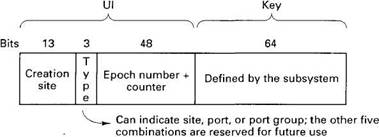Книга: Distributed operating systems
9.1.4. Kernel Abstractions
9.1.4. Kernel Abstractions
The kernel (by which we mean the microkernel) provides and manages six key abstractions that together form the basis for Chorus. These concepts are processes, threads, regions, messages, ports, port groups, and unique identifiers. They are illustrated in Fig. 9-2. Chorus processes (still called actors in the Chorus documentation) are essentially the same as processes in other operating systems. They are containers that encapsulate resources. A process owns certain resources, and when the process disappears, so do its resources.
Within a process, one or more threads can exist. Each thread is similar to a process in that it has its own stack, stack pointer, program counter, and registers. However, all threads in a process share the same address space and other process-wide resources. In principle, the threads of a process are independent of one another. On a multiprocessor, several threads may be running at the same time, on different CPUs. All three kinds of processes can have multiple threads.
Each process has an address space, normally going from 0 to some maximum address, such as 2??–1. All the threads in a process have access to this address space. A consecutive range of addresses is called a region. Each region is associated with some piece of data, such as a program or a file. In systems that support virtual memory and paging, regions may be paged. Regions play a major role in memory management in Chorus.

Fig. 9-2. Processes, threads, regions, messages, and, ports are identified by UIs.
Threads in different processes (potentially on different machines) communicate by passing messages. Messages can have a fixed part and a variable-sized body, both of which are optional. The body is untyped and may contain whatever information the sender puts into it. A message is addressed not to a thread, but to an intermediate structure called a port. A port is a buffer for incoming messages and holds those messages received by a process but not yet read. Like a thread, region, or other resource, at any instant, each port belongs to a single process. Only that process can read its messages. Ports can be put together to form port groups. These groups will be discussed below.
The last kernel abstraction relates to naming. Most kernel resources (e.g., processes and ports) are named by a 64-bit unique identifier or UI. Once a UI has been assigned to a resource, it is guaranteed never to be reused for another resource, not even on a different machine a year later. This uniqueness is guaranteed by encoding in each UI the site (machine or multiprocessor) where the UI was created plus an epoch number and a counter valid in that epoch. The epoch number is incremented each time the system is rebooted.
UIs are just binary numbers and are themselves not protected. Processes can send UIs to other processes in messages or store them in files. When a UI is transferred across the network and the receiver tries to access the corresponding object, the location information in the UI is used as a hint for where the object might be.
Because UIs are long and expensive to use, local identifiers or LIs are used within a single process to identify resources, similar to the use of small integers as file descriptors to identify open files in UNIX.
The kernel abstractions are not the only ones used by Chorus. Three other abstractions that are jointly managed by the kernel and subsystems also are important. These are capabilities, protection identifiers, and segments. A capability is a name for a resource managed by a subsystem (or, in a few cases, by the kernel). It consists of the 64-bit UI of a port belonging to that subsystem and a 64-bit key assigned by the subsystem, as shown in Fig. 9-3.

Fig. 9-3. A capability in Chorus.
When a subsystem creates an object, such as a file, it returns to the caller the capability for the object. From the capability, that process, or any subsequent process acquiring the capability, can find the UI of a port to which messages can be sent to request operations on the object. The 64-bit key must be included in such messages to tell the subsystem which of its many objects is being referenced. Included in the 64 bits is an index into the subsystem's tables, to identify the object. Other bits are randomly chosen to make it difficult to guess valid capabilities. Like UIs, capabilities may be freely passed in messages and files. This naming scheme was taken from Amoeba (Tanenbaum et al., 1986).
Memory management in Chorus is based on two concepts, regions, which were described above, and segments. A segment is a linear sequence of bytes identified by a capability. When a segment is mapped onto a region, the bytes of the segment are accessible to the threads of the region's process just by reading and writing addresses in the region. Programs, files, and other forms of data are stored as segments in Chorus and can be mapped onto regions. A segment can also be read and written by system calls, even when it is not mapped onto a region. An example address space is shown in Fig. 9-4.




